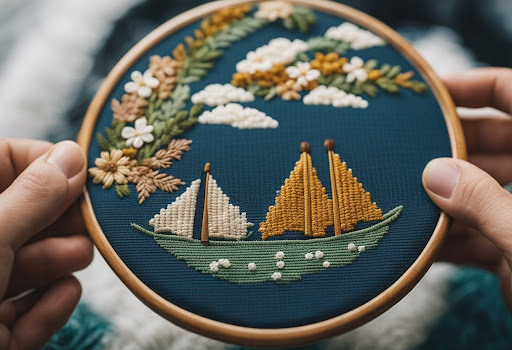Continental Tent Needlepoint Stitch Tutorial: A Step-by-Step Guide
Continental Tent Needlepoint, often referred to as the Basketweave Stitch, is a fundamental technique used in needlepoint that allows for even, durable coverage of the canvas. It's essential for stitchers of any level to master this stitch as it forms the backbone of many patterns and provides a smooth, textured finish that is less prone to distortion. Understanding this stitch can elevate your needlepoint projects, creating a professional look even if you are just a beginner.
_1.jpg)
Once accustomed to the rhythm of the Continental Tent Needlepoint Stitch, you will find it to be a meditative practice. The stitch involves alternating diagonal rows of one simple stitch, making it a perfect project for crafters seeking a straightforward yet engaging challenge. The technique requires minimal materials, which means after a quick setup, you can dive straight into practising the stitch. With patience and practice, anyone can achieve neat and consistent stitches, setting a strong foundation for more complex needlepoint work in the future.
Key Takeaways
- The Continental Tent Needlepoint Stitch is a basic, versatile stitch that provides a foundation for needlepoint projects.
- It's accessible for beginners and offers a consistent, professional finish with a simple alternation pattern.
- The stitch requires few materials, allowing crafters to quickly learn and apply the technique to their creations.
What You'll Need
_1.jpg)
To embark on your adventure with the Continental Tent Needlepoint Stitch, it's crucial to gather the right tools and materials. Here's a list of essentials:
Materials:
- Yarn or Embroidery Floss: Choose colours that complement your design.
- Needlepoint Canvas: Opt for a size appropriate for your project—small for beginners.
Tools:
- Tapestry Needle: A size 18 to 22 needle works well for most canvases.
- Scissors: A sharp pair for snipping yarn cleanly.
- Embroidery Hoop (optional): To keep your canvas taut while stitching.
Accessories:
- Frame or Stretch Bars (optional): For larger projects, to maintain an even tension.
- Magnification Tools (optional): If you need a closer look at intricate details.
- Lighting (optional): Good lighting can ease the strain on your eyes.
Here's a quick reference table for your convenience:
|
Category |
Item |
Note |
|
Materials |
Yarn/Embroidery Floss |
Colour coordinated with your project |
|
Materials |
Needlepoint Canvas |
Sized to suit your design |
|
Tools |
Tapestry Needle |
Size 18-22 recommended |
|
Tools |
Scissors |
Sharp for clean cuts |
|
Accessories |
Embroidery Hoop |
Optional, for keeping canvas taut |
|
Accessories |
Frame/Stretch Bars |
Optional, for larger projects |
|
Accessories |
Magnification Tools |
Optional, for detailed work |
|
Accessories |
Lighting |
Optional, but helpful for visibility |
Before beginning, ensure you're comfortable with your setup and everything is to hand. Effective preparation will make your stitching experience enjoyable and your project a success.
Instructions

To create the Continental Tent Needlepoint Stitch, follow these simple steps:
Step 1: Prepare the Needle and Yarn
- Thread the yarn through the eye of the needle. Ensure the length is manageable to prevent tangling.
Step 2: Begin from the Back
- Start from the back of the canvas. Bring the needle up through a hole to the front, leaving a small tail of yarn at the back to secure later.
Step 3: Create the First Stitch
- Insert the needle diagonally one hole down to the left and pull through to the back. This forms a / shaped stitch on the front.
Step 4: Continue the Row
- Move to the next hole directly to the right of your starting point and repeat, making sure the stitches lie parallel.
Step 5: Start the Next Row
- Begin the new row directly below the first, ensuring that the stitches form a neat diagonal line across the canvas.
Step 6: Secure the Yarn
- After completing several stitches, thread the needle under some completed stitches at the back to secure the yarn.
Tips for Better Stitches:
- Maintain even tension on the yarn for uniform stitches.
- Use a frame to keep your canvas taut.
- Regularly check the back for loose threads to avoid snags.
Keeping these instructions in mind, you'll be able to create a neat and consistent needlepoint piece with the Continental Tent Stitch. We encourage practice to refine technique and achieve the best results.


